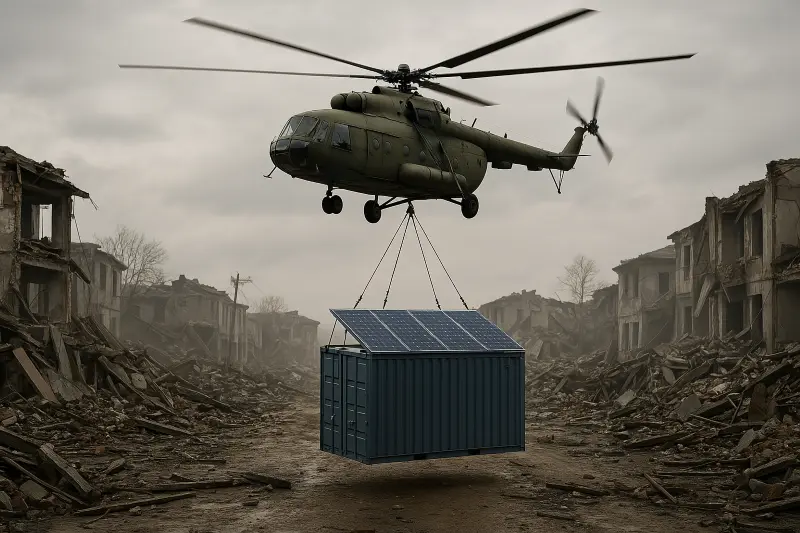The Urgency of Reliable Power Post-Earthquake
After a serious earthquake struck on March 28,2025, the calamity was far-reaching and not just damage to buildings. Power generation gets suspended, while hospitals are left in the dark and communications fail. In such situations, minutes count and reliable energy is not just a matter of convenience; it is a matter of life and death. Portable photovoltaic power plants have become a boon in all situations by providing almost instant off-grid electricity support for vital rescue and recovery operations.
Portable Photovoltaic Power Plants Impacting Disaster Reliefisaster Relief
Portable photovoltaic power plants are very rapidly deployable and can be set up in just a few hours, providing the most critical energy in such times when common infrastructure has failed. This technology has proven itself particularly in disaster scenarios by:
- Restoring Critical Services: In areas such as those affected by earthquakes, portable PV systems shall be providing power for emergency communication networks, lighting for rescue operations, and medical equipment used in temporary clinics.
- Reducing Dependency on Conventional Fuel: Unlike diesel generators, PV systems use sunlight, which is a free, inexhaustible resource. This causes less of a logistical burden and is more environmentally friendly.
- Enabling Flexibility: Their containerized design allows them to be easily transported and redeployed-an ever-evolving location.
For example, during the Myanmar earthquake, rescuers set up portable PV systems in makeshift hospitals and emergency command centers. In one account, power was provided to a remote field hospital in six hours after the disaster, enabling various critical surgeries to take place and with some patients stabilized, as opposed to having to wait for power.
Real-World Success Stories
Across the globe, there are numerous examples of portable PV power plants making a significant difference:
- Southeast Asia Relief Efforts: During the recent earthquake in a bordering area, emergency responders quickly installed portable PV units that powered communication hubs and supplied electricity to water purification systems. The efforts not only saved lives but also rejuvenated hope in affected communities.
- Industrial Applications in Remote Areas: The same portable solar system was deployed in a mining site in Australia to replace diesel generators for the sake of cutting down fuel costs by over 60%, while enabling continual operations under difficult climatic conditions.
- Community Support in Rural Regions: Rural schools and clinics enjoyed steady power from portable PV plants that very much ease life and the prospects for sustainable development in areas with little grid connectivity.
The above cases show the greatest ability of portable photovoltaic power plants to intervene in emergencies and in regular applications. They act as a reliable solution whenever conventional power comes short, thus strengthening the case for their widely being used in disaster-prone areas.
A Brief Look at the LZY-MSC1 Mobile Sun Container System
Although there are numerous portable PV options available to choose from, the LZY-MSC1 Mobile Sun Container System is a unique breed with capabilities that further set it apart, thanks to its robust performance and ease of deployment. Simple upon design, incorporate high-efficiency solar panels and scalable lithium battery storage inside a small transportable container.
| Specification | LZY-MSC1 Mobile Sun Container System |
|---|---|
| Deployment Time | Within 24 hours |
| Solar Array Power Range | 20 – 200kwp |
| Battery Storage Options | 100 – 500kWh |
| Charging Time | 4 – 6 hours |
| Operating Temperature Range | -25℃ to 65℃ |
| Installation Crew | As few as 4 people |
Simply put, the LZY-MSC1 represents what is easy for setup and simple for integration into existing emergency plans. Its containerized design allows for rapid deployment to disaster zones so that energy is provided again exactly when it is needed.
How portable photovoltaic power plants are driving future resilience?
The recent earthquake in Myanmar has underscored a very important truth: without resilient energy solutions, it is nearly impossible to efficiently respond to disasters. Portable photovoltaic power plants not only chip away at the immediate debilitating impact of the failure of civil infrastructures but also help prepare communities to be more resilient. Rapid deployment, environmental advantages, and operational flexibility render them to be indispensable in the disaster management toolkit.
These systems are more and more becoming the choice of organizations working with emergency relief and long-term development, and the LZY-MSC1 Mobile Sun Container System, reliable and quick-to-set-up, provides a worthwhile option for aid agencies and companies intending to better tackle responses in disaster situations.
Portable PV power plants symbolize a real ray of sustainability and hope in a fast-changing world where natural calamities pose a perennial danger. The investment in technologies like the LZY-MSC1 will ensure that the concerned stakeholders keep the communities powered, connected, and resilient in disastrous situations.

